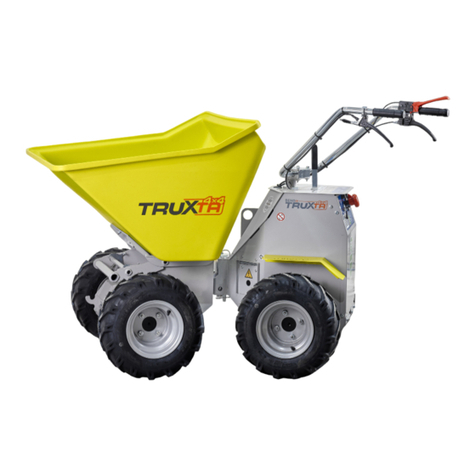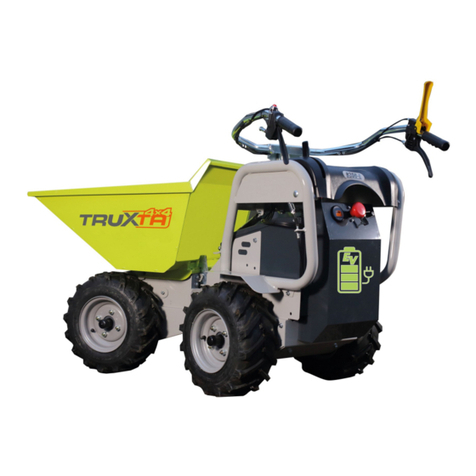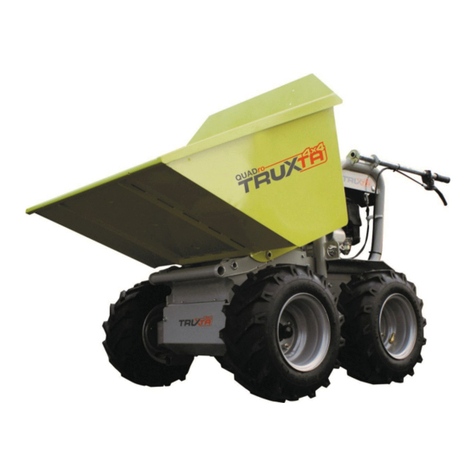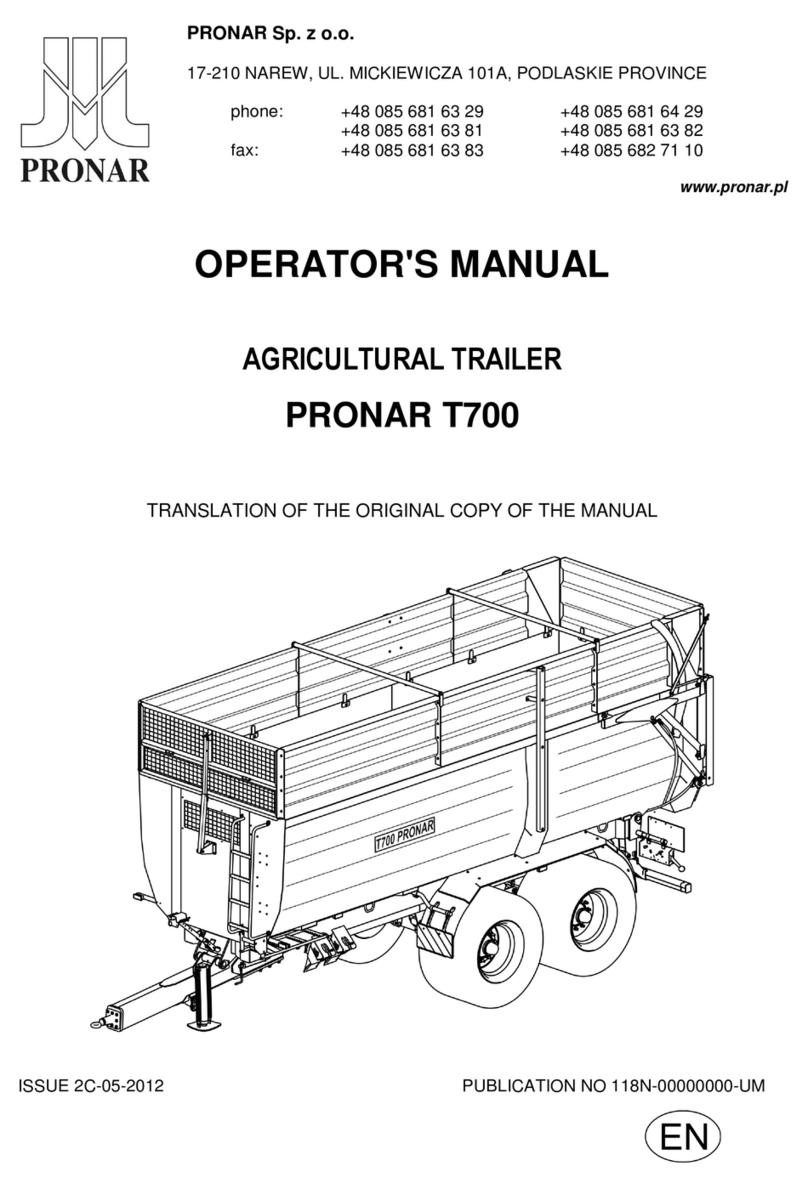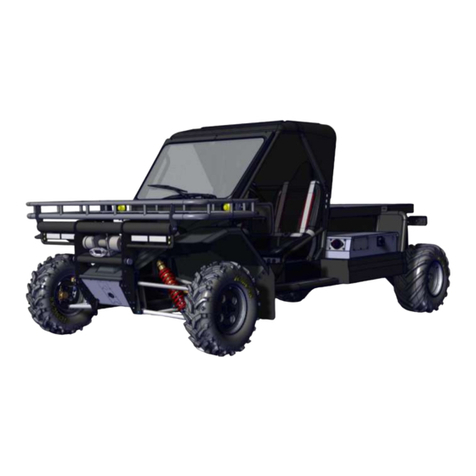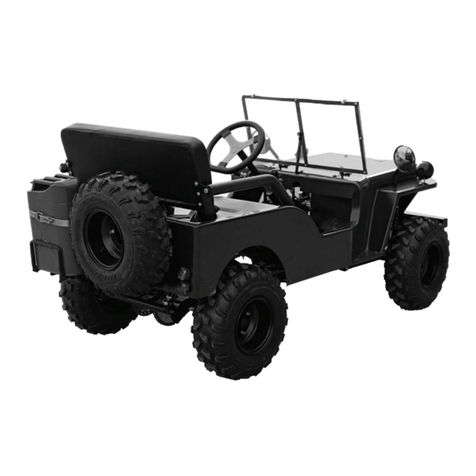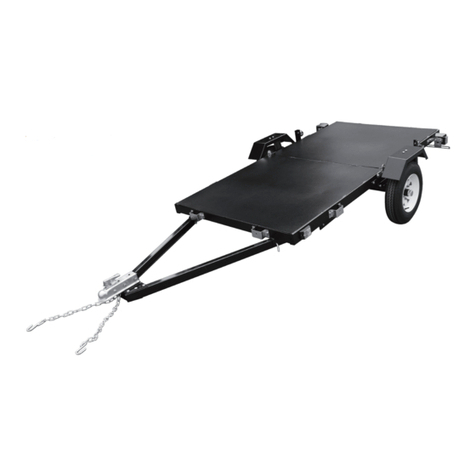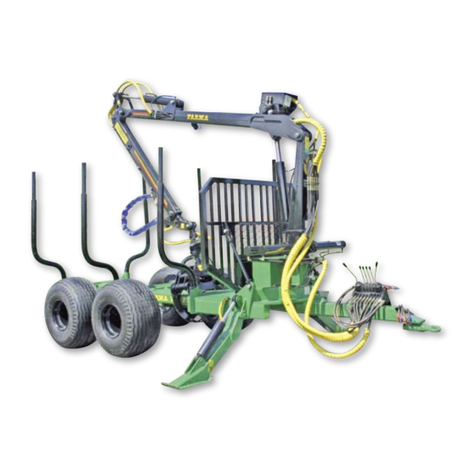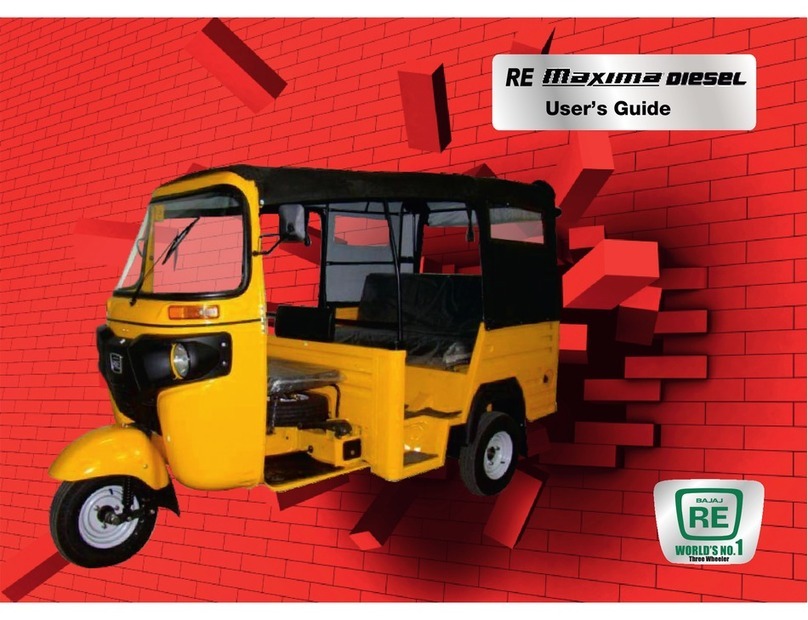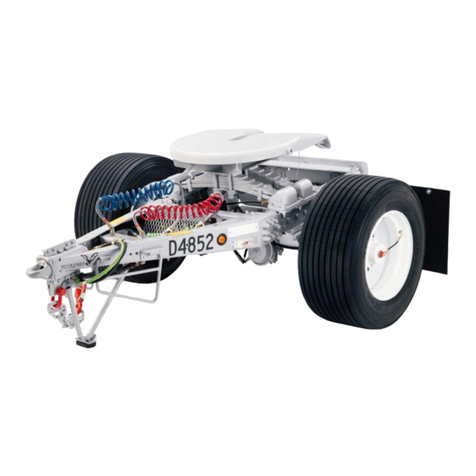Truxta MINI 3M Installation and operation manual

Machine Models
MINI 3M
MAXI 4.5M
OPERATOR MANUAL & PARTS LIST

Page 2
OWNER NOTES

Page 3
TABLE OF CONTENTS
INDEX
EC declaration of conformity .......................................................................................................................... Page 4-5
User instructions .............................................................................................................................................. Page 6
1. Purpose and use .................................................................................................................................... Page 6
2. Area of application ............................................................................................................................... Page 6
3. Deployment options............................................................................................................................... Page 6-7
4. Entry into use......................................................................................................................................... Page 7-9
5. Periodic inspection and cleaning .......................................................................................................... Page 10
6. Replacing components........................................................................................................................... Page 11
7. Transport and storage ............................................................................................................................ Page 12
8. General safety instructions ..................................................................................................................... Page 13
9. Safety instructions for hirers! .................................................................................................................. Page 14
10.User instructions for hirers! ................................................................................................................... Page 15
Deployment diagram ........................................................................................................................................... Page 15
Diagrams of accessories ....................................................................................................................................... Page 16
Parts list................................................................................................................................................................. Page 17
General assembly plan.......................................................................................................................................... Page 18
Diagram switch box.............................................................................................................................................. Page 19
Diagram accessories ............................................................................................................................................. Page 19
Electrical circuit diagram...................................................................................................................................... Page 20
Emergency stop diagram ..................................................................................................................................... Page 21
Owner Notes ……………………………………………………………………………………………………………………………….….. Page 22
Warranty Registration Form............................................................................................................................... Page 23
Truxta Dealer & Contact Details …………………………………………………………………………………………….………….. Page 24

Page 4
etramo bvba
Bisschoppenhoflaan 633
B-2100 Antwerpen
Tel.: 32/(0)3/326.02.92.
Telefax: 32/(0)3/326.51.62.
EC declaration of conformity of a machine with the machinery
directive (98/37/EC, amended by 98/79/EC) and the provisions
implementing it in national legislation.
The manufacturer: Etramo bvba
Bisschoppenhoflaan 633
B - 2100 Deurne
België
hereby declares that the machine:
Conveyor belt
Type: Mini-Maxi
Serial number: 45S
Year of manufacture:
fulfils the provisions of the European machinery directive (directive
98/37, amended by 98/79/EC) and the provisions to implement it in national
legislation,
and also fulfils the provisions of the following European directives:
• low voltage directive 73/23/EEC, amended by 93/68/EEC
• EMC directive 89/336, amended by 91/263/EEC, 92/31/EEC,
93/68/EEC, 93/97/EEC
At: Antwerp
10/09/2008
R. Tropato
Business Manager
UK & Eire: The range of Etramo manufactured conveyor belts are distributed in the UK by Tufftruk Ltd and branded Tuffbelt
EC DECLARATION OF CONFORMITY

Page 5
etramo bvba
Bisschoppenhoflaan 633
B-2100 Antwerpen
Tel.: 32/(0)3/326.02.92.
Telefax: 32/(0)3/326.51.62.
EC declaration of conformity of a machine with the machinery
directive (98/37/EC, amended by 98/79/EC) and the provisions
implementing it in national legislation.
The manufacturer: Etramo bvba
Bisschoppenhoflaan 633
B - 2100 Deurne
België
hereby declares that the machine:
Conveyor belt
Type: Mini-Maxi
Serial number: 3S
Year of manufacture:
fulfils the provisions of the European machinery directive (directive
98/37, amended by 98/79/EC) and the provisions to implement it in national
legislation,
and also fulfils the provisions of the following European directives:
• low voltage directive 73/23/EEC, amended by 93/68/EEC
• EMC directive 89/336, amended by 91/263/EEC, 92/31/EEC,
93/68/EEC, 93/97/EEC
At: Antwerp
10/09/2008
R. Tropato
Business Manager
UK & Eire: The range of Etramo manufactured conveyor belts are distributed in the UK by Tufftruk Ltd and branded Tuffbelt
EC DECLARATION OF CONFORMITY

Page 6
1. PURPOSE AND USE
2. AREA OF APPLICATION
3. DEPLOYMENT OPTIONS
The conveyor belt has been designed to transport solid (non-liquid), non-dangerous materials such as sand,
gravel, rubble, agricultural crops, etc.
The material being moved must be loaded on the conveyor belt with a sense of professional skill so that no
damage is caused by overflowing.
A maximum of 3 conveyor belts of 3 metres can be linked in series on one 115V - 16A power supply (figure5).
A maximum of 2 conveyor belts of 4,5 metres can be linked in series on one 115 -16A power supply (figure5).
A large hopper is placed on the first conveyor belt (figure 1). This keeps the deposited material on the belt.
Each conveyor belt is held up by a trestle support (figure 3) or a set of pipes. Supporting pipes are
provided in the frame for the assembly of a set of pipes.
The conveyor belt can be used in roofed areas as well as outdoors in humid environmental conditions.
The conveyor belts are separate from each other and can be deployed in series.
They must be deployed in a way that ensures they cannot shift, i.e. the chair or pipes construction must stand
on a solid foundation.
The conveyor belt cannot be supported by the small hopper.
In the longitudinal direction they can be placed at any angle to the previous conveyor belt.
The conveyor belt must always be filled via the large hopper, i.e. items must never be filled directly onto
the belt.
The conveyor belt must always be level in the width direction. This is to prevent the belt from slanting.
The rubber belt must be able to run unimpeded on the underside of the conveyor belt without touching the
ground or any other obstacle. Filling between rubber conveyor belt spaces must absolutely be avoided.
USER INSTRUCTIONS

Page 7
The following deployments are possible:
1. Deployment in a straight line and deployment on a slope in series (figure 5).
• The conveyor belts cannot be placed on top of each other.
• The conveyor belt sits on the ground on the filling-side.
• At the output side, the conveyor belt sits on a chair, set of pipes or (for example) a container.
• The conveyor belt is positioned in such a way that the output of the material ends up in the
small hopper (fig.2).
• The gradient depends on the type of the materials being transported and their weight.
2. Deployment where the conveyor belts are not placed behind each other.
• The conveyor belts can be deployed and arranged at every angle.
• The conditions for deployment are the same as in point 1.
IMPORTANT: read all of the information stickers on the machine very carefully
Please refer to the next chapter ‘Entry into use’ for information on linking several conveyor belts.
4. ENTRY INTO USE
When using the conveyor belt for the first time, it might need to be adjusted. (see paragraph 6.4)
Each conveyor belt is supplied with a power cable that enables the user to connect the device to the 230V
mains network.
POWER CABLE
• 3M: the consumption per conveyor belt is 4,6 A.
• 4.5M: the consumption per conveyor belt is 5,0 A.
USER INSTRUCTIONS

Page 8
It is advisable to start the conveyor belt unloaded to prevent the thermal fuses on the motor and/or switch
from triggering.
In certain circumstances (non-overloaded belt and small slope), the conveyor belt can nonetheless
be started while loaded.
WARNING: if the belt does not start to move, switch off the motor immediately.
Linking Several Conveyor Belts.
3M: when the conveyor belt enters service the user must ensure that the leads cannot be damaged.
A maximum of 3 conveyor belts of 3 metres can be connected behind each other using a secured 16 A
mains power supply. The conveyor belts can be coupled via a linking lead so that a separate power supply
(115V) does not have to be provided for each belt.
4.5M: when the conveyor belt enters service the user must ensure that the leads cannot be damaged.
A maximum of 2 conveyor belts of 4,5 metres can be connected behind each other using a secured 16 A
mains power supply. The conveyor belts can be coupled via a linking lead so that a separate power supply
(115V) does not have to be provided for each belt.
The last conveyor in the series must be equipped with an end plug.
3M: if the user wishes to use more than 3 belts, a separate mains power supply must be provided for
every 3 conveyor belts.
4.5M: if the user wishes to use more than 2 belts, a separate mains power supply must be provided for
every 2 conveyor belts.
Each conveyor belt can be started separately by using the start button. The start button is green in colour.
A red (emergency) stop button is located at the end sides of the conveyor belt.
‘Stop’ not only halts the conveyor belt on the machine where the stop button was pressed but also all
conveyor belts that are connected to the same power supply.
Only switch on live power to the conveyors when ALL conveyors have been fully set-up and
electrically connected!
Never connect/disconnect or clean conveyors that are attached to live power!
USER INSTRUCTIONS
THERMAL FUSE
If the conveyor belt is overloaded
the motor stops thanks to the built-
in thermal fuses in the motor and
switch unit.

Page 9
STOP
EMERGENCY STOP
CONNECTING TABLE
START
When restarting the conveyor belt, the various conveyor belts all have to be started up separately.
Always start the last one in the series first.
Installation of a large hopper (figure 1 page 16).
A large hopper is placed at the start of the first conveyor belt (figure 5 page 15).
Installation of a small hopper (figure 2 page 16).
A small hopper is fitted on the piling-up side of the conveyor belt above the support groove (figure5page15).
SUPPORT GROOVE
USER INSTRUCTIONS

Page 10
5. PERIODIC INSPECTION AND CLEANING
See assembly plan (page 18)
1. Inspection:
The driving roller, accompanying roller and trough rollers must be checked regularly and cleaned if
necessary.
It is very important for no material residue to be left behind on the roller. Conveyed material that
gets stuck between the roller and belt can be very damaging and can lead to the system breaking.
Also inspect the operation of the belt scraper regularly.
2. Cleaning
The conveyor belt can be rinsed with a water hose (maximum pressure: 5 bar)
WARNING:
Caution is advisable when you perform the task.
Uncouple the conveyor belt from the power supply!
Do not aim the water hose directly at the electricity box.
Never scrape the belt or drums with your hands or sharp objects.
USER INSTRUCTIONS

Page 11
See assembly plan (page 18)
Replacing the rubber belt:
1. Dismantling the rubber belt:
Method and sequence:
• Detach bolts no.6.
• Remove intermediate part no.5 at the front of the conveyor belt.
• Detach the cover plates no.18
• Remove belt scraper no.9 by pulling it over the hinge points (side by side).
• Loosen nuts no.14 and remove supporting roller no.16.
• Unblock nuts no.3 and take the depth at which bolts no. 4 are screwed in as the reference
measurement.
• Loosen bolts no.4 (fully).
• Lift the accompanying roller out of the groove (upwards) and take it out of the frame.
• Hook the belt above the guidance grooves.
• Take the rubber belt away, starting with the driving roller.
• IMPORTANT: make sure that the driving roller does not move out of the slides!
• Ensure that the motor cable is lying in the safety groove.
2. Assembling the rubber belt.
Method and sequence:
• Assemble the belt in the reverse order to dismantling.
3. Adjusting the rubber belt for tension.
Method and sequence:
• Screw bolts no.4 tight alternately until the tightening depth is reached!
4. Adjusting the rubber belt for parallelism.
Method and sequence:
• If the belt runs against the frame on one side, tighten screws no. 4 by a ¼ turn at the side where the
belt touches the frame (or loosen the screws on the opposite side).
• Allow the belt to turn by a few belt lengths and check it in the meantime.
WARNING: CAUTION is advisable.
This work is NEVER done while the conveyor belt is running or electrically powered.
AVOID ACCIDENTS.
IMPORTANT:
• Never replace parts when the belt is electrically powered.
• Only use original components at replacement.
• Replacements or repairs other than those listed in these user instructions
(especially the electrical aspects) can only be executed by technically competent staff).
USER INSTRUCTIONS
6. REPLACING COMPONENTS

Page 12
7. TRANSPORT AND STORAGE
1. Transport:
Two people can easily move the conveyor belt. To do this use the specially designed wheel system
(see figure 6 page 16). These carrying wheels are a handy means of transport, even on uneven ground.
Using the Wheel system:
Lift-up the conveyor belt on the side where the wheel system is being mounted (see fig. 6-A page 16) and fit
the wheel system into the opening provided (fig. 6-B page 16).
The conveyor belt can now be lifted on the other side and moved along.
2. Storage
A maximum of 6 conveyor belts can be placed above each other.
When stacking, the semi-circular support rings are placed in the grooves on the conveyor belt
lying beneath (figure 4 page 16).
USER INSTRUCTIONS

Page 13
8. GENERAL SAFETY INSTRUCTIONS
IMPORTANT
• People cannot ‘hitch a ride’ on the Mini-Maxi in any circumstance.
Keep children away.
• If the Mini-Maxi is deployed at a height, all precautions must be taken to prevent con-
veyed material from falling out (e.g. onto staff).
• The Mini-Maxi can never be deployed in a position where the electrical contacts are
underwater.
• If the deployed installation becomes blocked during use, all conveyor belts must be
halted before the cause is removed.
• Never work on the conveyor belt while it is electrically powered.
• The conveyor belt can be rinsed with a maximum water pressure of 5 bar.
USER INSTRUCTIONS

Page 14
9. SAFETY INSTRUCTIONS FOR HIRERS
10. USER INSTRUCTIONS FOR HIRERS
To ensure safe, correct use of the machine, you must read this text thoroughly in advance.
Do not allow the conveyor belt to be used by minors or unauthorised persons.
Keep other people at a distance and never leave the conveyor belt unsupervised.
Children or anyone else can never ‘hitch a ride’ on the conveyor belt in any circumstance.
Only use the conveyor belt for materials that are not harmful or dangerous.
Never transport materials that could adversely affect or damage the conveyor belt.
Load the material on the conveyor belt in a way that ensures nothing can fall off over the side.
Start the conveyor belt unloaded to prevent the fuses from switching off the power.
If the machine is overloaded the thermal fuse switches the motor off. Wait for some time. The conveyor
belt can only be restarted with the start button when the fuse has been restored to its original state.
Stack a maximum of 3 conveyor belts on top of each other during storage or transport.
The conveyor belts can be set up behind each other. Begin at the end point and install a small hopper. Put the end of
the next conveyor belt above it with a chair construction that sits on the ground. Ensure that it is deployed in a stable
way. Also ensure that the conveyor belts cannot shift.
Equip the first belt with the large filling hopper, especially on a steep slope. When deploying on a slope the conveyor
belts must be supported separately with a sturdy pipe construction.
Build the construction based on the pipe provided in the frame.
Ensure that the conveyor belts themselves can always run unimpeded on their underside without touching the ground
or another obstacle.
The conveyor belts can only be deployed at an angle in the longitudinal direction. In the width direction they must
always be level to prevent the belt from slanting.
The gradient is limited by the type of material being transported and its weight.
The conveyor belts can also be deployed in a falling line.
Connecting leads are used for coupling. Ensure that these cannot be damaged or dragged along. Only use the electrical
lead of the belt itself in dry weather conditions. If the conveyor belt is used in humid conditions connect the electricity
directly to the built-in socket. During set-up prevent electrical parts from being able to slip underwater.
For 3M —Connect a maximum of 3 conveyor belts electrically on a 16 A power supply.
For 4.5M —Connect a maximum of 2 conveyor belts electrically on a 16 A power supply.
Use extension leads (minimum 2.5 mm²) with an earth and always roll them out in full. Always ensure that the power
supply is equipped with a differential switch and an earth leak switch.
The conveyor belt is activated by using the green start button. The red button halts the belt of all conveyor belts that
are connected to the same power supply.
After the electricity is switched off, the machine is to be rinsed with a water hose and thoroughly cleaned.
USER INSTRUCTIONS

Page 15
DEPLOYMENT DIAGRAM
The belt can be adjusted in height using the
posion of the support
Small Hopper
Support
Large Hopper
Container
figure 5

Page 16
DIAGRAM OF ACCESSORIES
Large Hopper - fig.1
Support - fig. 3
Small Hopper - fig. 2
Transport Wheels - fig. 6
Stacking - fig. 4
20kg 10kg

Page 17
PARTS LIST —TUFFBELT CONVEYORS 3 & 4.5 METRE MINI-MAXI 115V/230V
Item No. Part No. DESCRIPTION
1 107-00801 Frame end cap - black
2 107-00711 Return roller type D
3 8-10003 Nut M10
4 7-10110 Set screw M10 x 110
5 107-00831 Connecting piece
6 7-8020 Set screw M8 x 20
7 8-8001 Nut M8
8 107-01657 Decal Wheel set 50kg (3m conveyor belt)
8a 107-01658 Decal Wheel set 70kg (4,5m conveyor belt)
9 107-00853 Belt scraper complete
10 107-01395 Belt scraper complete metal bar (set)
11 107-00544 Decal direction of rotation
12 107-01807 6 Pole Socket outlet
13 107-00886 Roller diam.50 L=185
14 8-12006 NyLock nut M12
15 4-1204 Washer M12
16 107-00733 Support roller
17 107-01710 Emergency stop button complete
18 107-01540 Side plates (set of 4 pieces)
19 107-00885 Chassis conveyor belt complete (3m conveyor belt)
19a 107-00863 Chassis conveyor belt complete (4,5m conveyor belt)
20 107-00421 Decal 110V
21 107-01882 Control box model -110V-6A (3m conveyor belt)
21a 107-01870 Control box model -110V-7A (4.5m conveyor belt)
21b 107-01878 Control box model - 230V-3.5A (4.5m conveyor belt)
22 107-00626 Capacitor 50mf (110v -3m)
22a 107-01891 Capacitor 60mf (110V - 4.5m)
22b 107-04184 Capacitor 25mf (230V)
23 107-00683 Bridge switch box
24 107-00543 Decal user instructions
26 107-00446 Drive roller 110V 0,37kW (3m conveyor belt)
26a 107-00447 Drive roller 110V 0,50kW (4,5m conveyor belt)
26b 107-00850 Drive roller 230V 0,50kW (4,5m conveyor belt)
27 107-01842 Emergency switch + button (3m conveyor belt)
27a 107-01809 Emergency switch + button (4,5m conveyor belt)
28 107-01810 Start button on control box
29 107-01934 Fuse 6.0 A - (110v - 3m conveyor belt)
29a 107-01091 Fuse 7.5 A - (110v - 4,5m conveyor belt)
29b 107-01932 Fuse 3.5 A - (230v - 4,5m conveyor belt)
30 107-00610 Fuse cover
31 107-01811 6-pole outlet control box
32 107-01812 End plug - six-pole
not shown 107-00808 3m conveyor belt moulding
not shown 107-00814 4,5m conveyor belt moulding
33 107-00810 Large hopper (TBH01)
34 107-00786 Side rubber large hopper
35 107-00785 Back rubber small hopper
36 107-00856 Small hopper (TBH02)
37 107-00843 Back rubber small hopper
38 107-00844 Side rubber small hopper
39 107-00862 Wheel set (TBW01)
40 107-00860 Conveyor Support Frame (TBS01)
41 107-01880 Power cable 110V
41a 107-01813 Power cable 230V
42 107-01814 Link cord (TBC01)
43 107-01093 Relay 230v - S3

Page 18
GENERAL ASSEMBLY PLAN CONVEYOR BELT
21a/21b
22a/22b
26a/26b
12
3
4
12
11
10
9
8/a
6
5
7
20
23
22
21
24 25 26
18
17
RETURN ROLLER SIDE
CONVEYOR BELT
MIDDLE
CONVEYOR
BELT
MOTOR SIDE
CONVEYOR BELT
19a
19
14
15
16
15
14
13

Page 19
SWITCHBOX DIAGRAM
ACCESSORIES DIAGRAM
27a
29a/29b
37 38
36
30
31
32
29
27 21 /21a/21b
28
353433
39
41/41a 42
40

Page 20
ELECTRICAL CIRCUIT DIAGRAM
End Plug
Emergency
Stop
External
Emergency
Stop
CapacitorMotor
Motor:
1. Brown
2. Black
3. Blue
4. White
5. Yellow
6. Purple
This manual suits for next models
1
Table of contents
Other Truxta Utility Vehicle manuals
Popular Utility Vehicle manuals by other brands
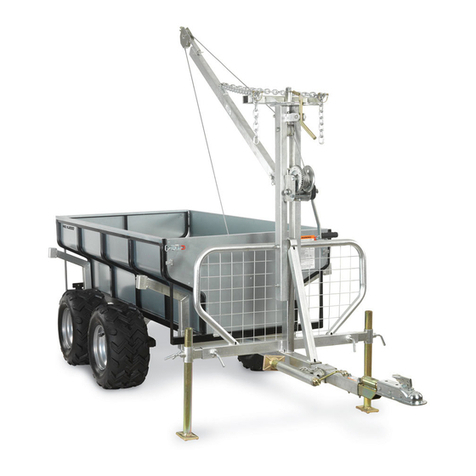
DR
DR VERSA TRAILER PRO XL2000 Safety & Operating Instructions

DINO CARS
DINO CARS GoKart AF Assembly instructions
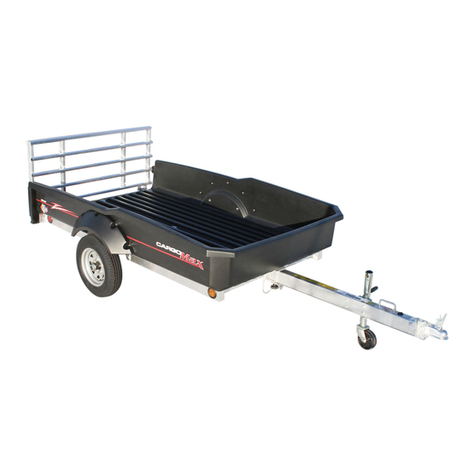
Floe
Floe CargoMax XRT owner's manual
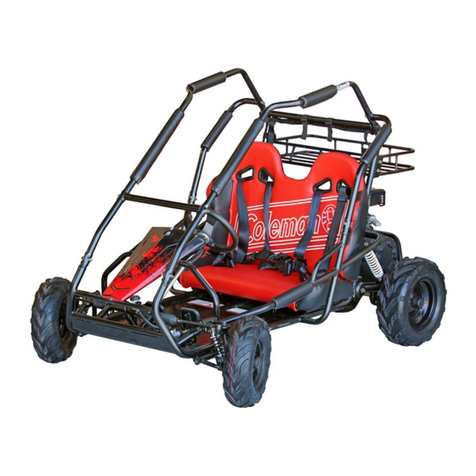
Coleman Powersports
Coleman Powersports KT196 owner's manual
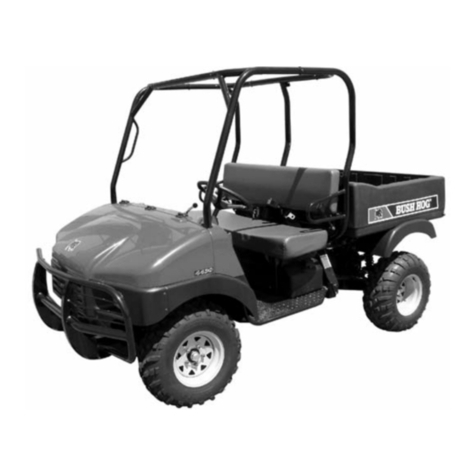
Bush Hog
Bush Hog Off Road Utility Vehicle 4430 Operator's manual

Toro
Toro 110-2626 installation instructions

